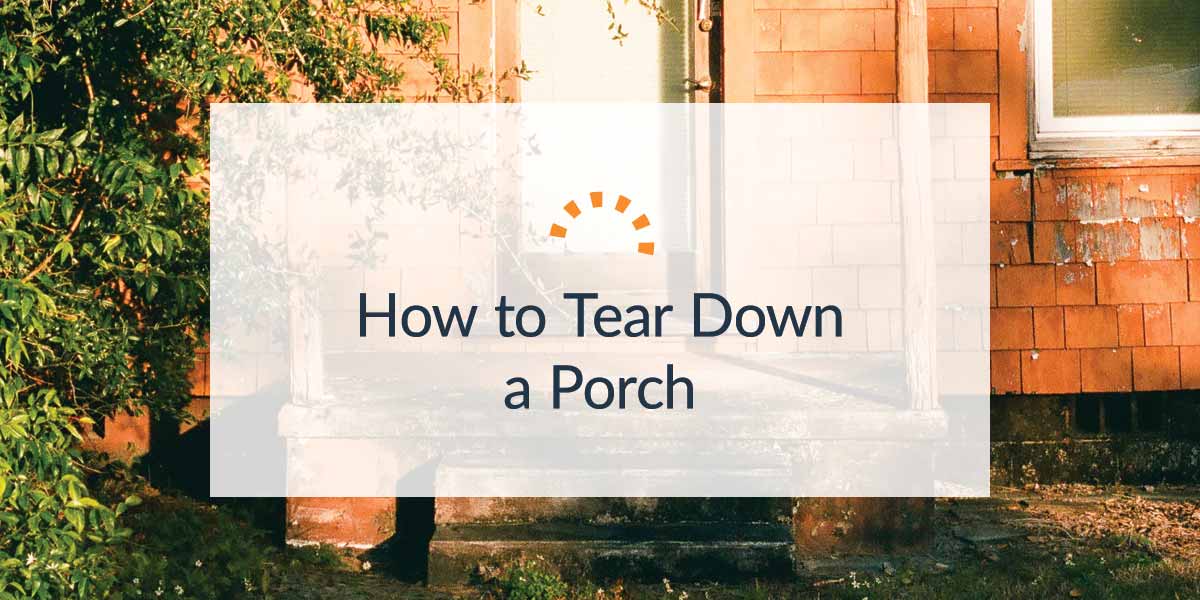
Whether your porch is simply outdated or rotten and falling apart, it may be time for a complete porch removal. This guide will help you work from the top down, starting with the roof of your porch, then the columns or screened areas and finally the floor and foundation. Some porch designs are simpler than others, so you might find that you can skip a step or two. Nevertheless, tearing out your porch is a multi-day project that requires plenty of tools, but it will pay off for your home.
PROJECT DIFFICULTY RATING: Intermediate
This guide is for a basic front porch with a roof, columns, flooring and a foundation. If your porch matches this design, let’s move on with the first steps of your DIY porch removal.

Below is all of the equipment you’ll need to remove the porch yourself. Bear in mind that you can borrow or rent some of these tools if you don’t have them on hand and don’t want to buy them.
Porch Removal Tool and Supply List |
|
|
Tools |
Supplies |
|
|
DIY porch removal will leave you with lots of debris, including shingles and floorboards. You can rent a dumpster for your project location to easily toss trash as you work.
Begin by dislodging the shingles and proceed to take down the roof frame. This DIY job is complex but rewarding, and will save plenty of money when compared to hiring professionals. For your reference, the cost of a professional porch demolition can range from $500 to $1000, and it can reach up to about $2000 if concrete removal is needed.
Pro-Tip: If your porch is rotting, be sure to check its stability before you begin working to avoid an unexpected collapse. Everyone around the porch during this job should wear safety gear and stay aware of any unstable areas.
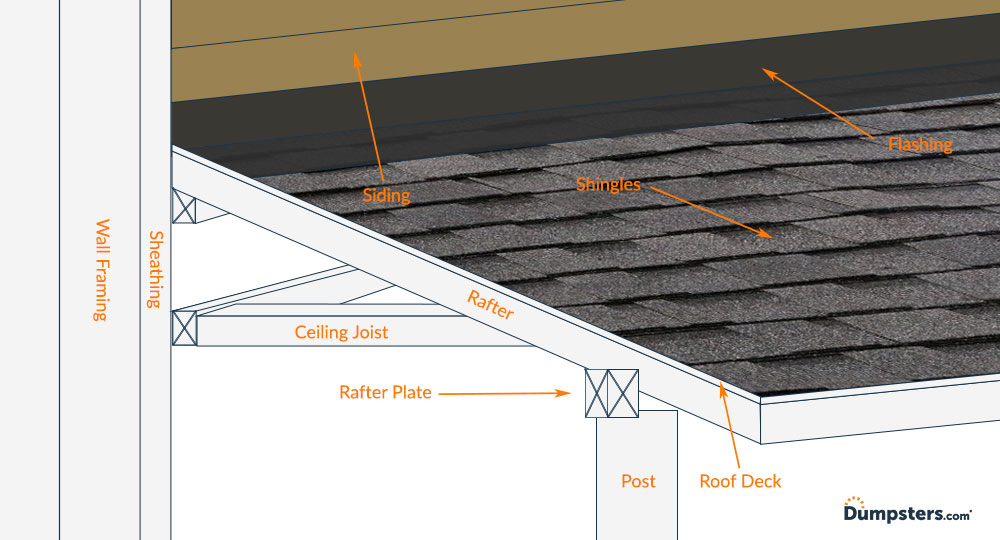
Use a ladder to access the roof and a shovel to dislodge the shingles. You should also peel the flashing away from where your porch roof connects to your home.
Joists are the horizontal beams connecting the porch roof to the home, and rafters are slanted beams that form the frame. If your porch roof is flat, then it only has joists, usually supported by trusses.
If you want to avoid buying or renting an electric saw, you can start by removing the nails on these beams with a hammer. Once you’ve done that, you should be able to pull the beams off the porch frame or knock them off with a sledgehammer. Even if some nails can’t be removed, the sledgehammer will take care of the frame.
If the nails can’t be pulled out, use a circular electric saw to cut through each beam as close to the house as possible. First, you’ll need to climb onto the porch roof and cut through the roof deck with your circular saw. You need to cut fully through the deck and across the entire length of the porch roof. Then, stand under the roof to cut through the joists. Remember to wear a hard hat to protect your head if wood or shingles begin to fall.
If the porch roof is looking unstable by this point, walk out from under it and finish knocking it free with a sledgehammer. If the porch roof is still stable, use the circular power saw to cut the roof deck into sections that can be ripped off by hand.

With the roof gone, this part will be straightforward since your porch columns are no longer supporting any weight.
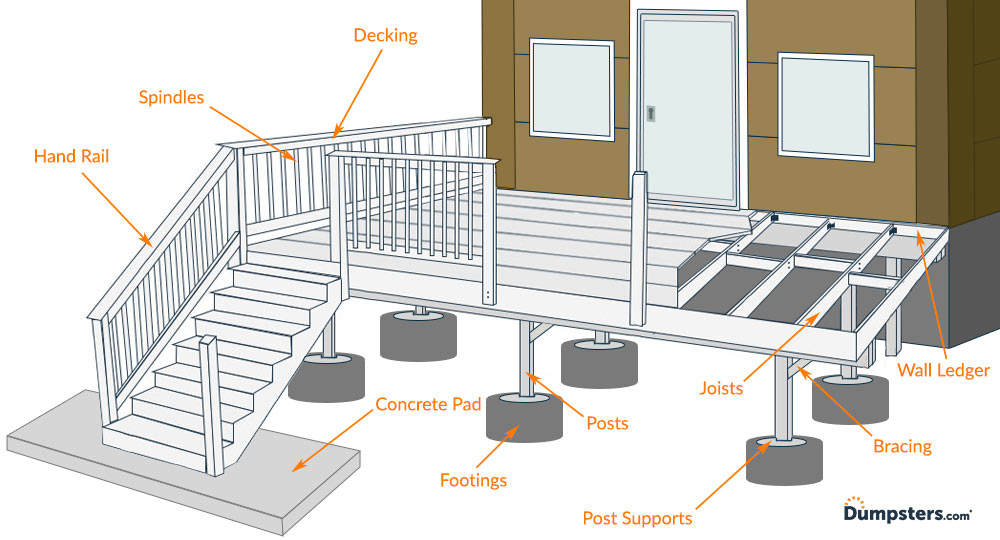
Be mindful of any rotten columns that might fall on their own. As always, make sure that your workspace is clear and that everyone in the area is wearing safety gear.
Use the claw side of your hammer or a power drill to remove any staples, nails or screws holding up the screen. Then, simply take the screen off your porch.
If your porch has either a solid railing or one with spindles, use a hammer to remove any nails connecting it to the columns. If the nails are too old to remove or painted over, you’ll need to use a pry bar to pull apart the railings. Next, gradually knock the railing free with a sledgehammer.
Pull out the nails connecting the columns to the floor. Knock the columns down with a sledgehammer if you need to, or pull them free with your hands if you want to preserve the columns for a future project.
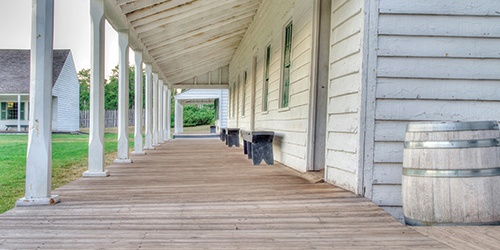
Removing your porch floor could take hours depending on the size of the porch, but the process can be simplified with the right equipment.
Use a circular saw to cut the boards down the middle into smaller pieces. You should set the length of your circular saw to avoid cutting through the supports under the floorboards for now. Also, be careful not to grind the saw against any brick or concrete around the boards. If you’re throwing out the boards, make sure to cut them into small enough pieces so that they won’t hang over the sides of a dumpster as you get rid of them.
Pro-Tip: If you plan to reuse the floorboards as part of another project, carefully remove the nails and dislodge the boards with a hammer to keep them intact.
Wear knee pads for comfort and use a pry bar in the sawed-out areas to rip out the boards. Use a hammer as necessary to remove any nails in the way. If the nails are stubborn or you’re working at a difficult angle, wedge a pry bar under the boards and then hit the pry bar with a mallet to remove it.
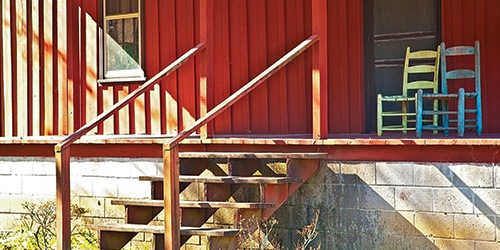
Once again, the type of porch you have will affect how long this part takes. Some porches are only made of wooden supports and a lattice cover, while others could be supported by cinderblocks or bricks, which take a bit more heavy lifting.
If your porch foundation is in good condition and you plan to build a new porch on it, you can skip this step.
Use a shovel to dig away dirt or grass to reveal the full length of the posts and the concrete foundation supporting them. Then, you can simply pull out the exposed concrete. From there, carefully use a chisel and hammer to take apart any bricks that supported the porch. You can even use a sledgehammer to knock apart brick or cinderblock sections.
Both the chiseling and sledgehammer methods are straightforward, but still require safety precautions. You can also use a combination of both methods. A sledgehammer can help break up an old brick wall if you have one on the front of your porch’s foundation, while a chisel and a claw hammer can clean up any bricks left behind.
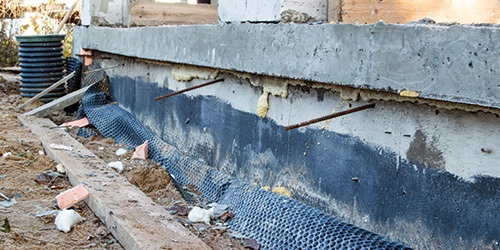
If your porch was supported by a concrete slab, you may want to have a professional come in and remove it, or if you have a pry bar and bolt cutters on hand, you can take care of it using these basic steps:
Make sure to consult our DIY guide on removing concrete patios for more helpful information.
Common Porch Removal Questions
If you’re unsure about your DIY expertise, the equipment you have on hand, or the complexity of your porch, hiring professionals can be helpful and time-saving. In particular, if your porch has glass walls, multi-season features, or lots of electric elements, you should consider consulting with a contractor.
Hiring professionals to remove your porch can vary widely but will generally cost around $750, even for removal of a simple wooden porch. To save money, you only need to gather some basic tools and safety equipment, then rent a dumpster for convenient waste disposal as you work. The average nationwide cost of a dumpster rental is $469.29 and our agreements come with a generous rental period to get the job done on your timeline.
The time your porch removal takes depends on the size and type of porch you have. If it’s only made of a simple roof and wooden beams, including the foundation, you might completely remove it over a weekend. Expect a full week of work if your porch has a brick foundation that needs to be chiseled apart, or if you want to keep the parts of your dismantled porch as undamaged as possible.
With the new space in front of your home, you have plenty of options. You could set up a garden to keep your home green, or you can hire professionals to install a beautiful new porch. The choice is up to you now that you’ve cleared the way for what’s next.